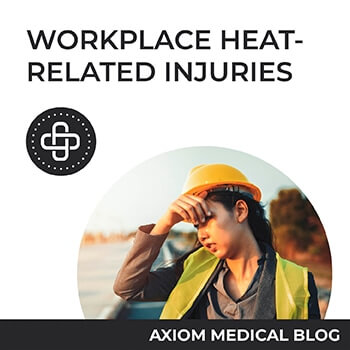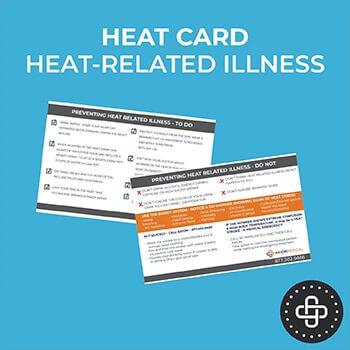Workplace heat-related injuries are real. Workers, especially those working outdoors, are often exposed to extreme heat and may be at risk of heat stress. While sun exposure is not harmful, extreme heat can result in sudden heat-related stress, illness, and even a stroke. Can workplace heat-related illness be avoided? Let’s find out.

Heat-Related Illness in Workplace and Its Causes:
Every year, a significant percentage of occupational illnesses and injuries in the construction and manufacturing industries come from heat-related stress. Heat stress can sometimes be fatal when exhaustion leads to severe lethargy and a sudden heatstroke. If not directly, heat can also indirectly affect your workers’ health and increase their risk of injuries due to sweaty palms, dizziness, and lethargy.
Who Is At Risk?
The outdoor workers, especially those who regularly work in hot environments such as firefighters, farmers, construction workers, miners, bakery workers, boiler room workers, and factory workers are at a greater risk of heat-related illness. Heat can also affect older workers of 65 years of age or older, overweight, and those with heart disease or high blood pressure.
What are The 3 Types of Heat Injuries?
The three major heat injuries at the workplace include heat cramps, heat exhaustion, and heatstroke.
Heat Cramps:
It may occur due to indoor or outdoor heat exposure. Light to severe cramps, muscle pain, tightness, and exhaustion are the symptoms of heat cramps. Usually, heat cramps are the first stage of heat emergency or illness.
Heat Exhaustion:
The second stage of heat-related symptoms of heat exhaustion include:
- Muscle cramps
- Mild confusion
- Dizziness
- Fast heart rate or breathing
- Headache
- Irritability
- Extreme thirst
- Nausea or vomiting
- Pale skin
- Heavy sweating
- Fainting
Heatstroke
The third-stage of heat-related illness is a heatstroke. In this case, all the symptoms of heat exhaustion may be present, plus:
- Body temp over 104°F
- Difficulty breathing
- Difficulty to focus and hallucinations
- Rapid breathing with confusion
- Rapid or weak pulse
- Seizures
- Lightheadedness
- Loss of consciousness
- Excessive sweating and heatstroke
Can Employers Help?
Employers can help their employees by training them to understand what heat stress is and its effects. Millions of outdoor workers are exposed to heat in their workplaces. The truth is heat exposure cannot be prevented but can be minimized. Helping your employees with tolerance building through heat acclimatization also helps. Lack of acclimatization often leads to heat stress and even fatal outcomes. The first step that employers may start with is by identifying the risk factors.
Identifying the Risk Factors:
Since occupational heat-related injuries are due to extreme environmental conditions, appropriate clothing is always recommended. Employers may train and help employees understand the proper attire for outdoor physical activity based on hot environmental conditions.
- Even though heat exposure cannot be avoided, it can be minimized. One of the best ways to do so is by improving tolerance which can be done through acclimatization.
- Employees of a certain age or with underlying health conditions are always at a higher risk of heat stress. Employers may consider job transfer options for such employees to protect them from heat-related illnesses.
- Employers must remember that hazardous heat exposure can occur indoors or outdoors. With proper gears, improving ventilation, and acclimatization, heat exposure at the workplace can be significantly minimized.
How to Prevent Heat-Related Injuries?
The best way to avoid a heat-related illness is by preventing exposure. Employers must educate and train their employees about heat-related emergencies and how to avoid them.
Employees must:
- Take precautions if they have underlying health conditions
- Rest as often as possible
- Hydrate themselves to avoid dehydration due to excessive perspiration
- Wear light-colored and cool-fabric clothing
- Avoid alcohol and other drugs
- Take immediate action when experiencing heat-related symptoms
Employers Must:
- Provide workers with water, shade, and rest
- Train employees about heat acclimatization (CDC Sun-Safe Strategies)
- Provide emergency healthcare services
- Monitor employees health to see signs of illness
Under the OSHA regulation, employers are responsible for keeping the workplace free of known safety hazards, including protecting workers from extreme heat. Employers with more outdoor workers exposed to high temperatures may want to consider establishing a complete heat illness prevention program as well.
Axiom Medical recently hosted a webinar on heat-related illness at workplace. Click below to watch the webinar.
SUMMER SAFETY – HEAT-RELATED ILLNESS
Click Below To Download Our Heat Card Today!

Axiom Medical is Here To Help!
Does your organization need an occupational healthcare program and OnSite health clinic to deal with emergency occupational injuries? Axiom Medical can help. With our employee total health program, we can help your organization with workplace healthcare needs. Contact us today to learn more!










